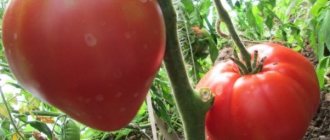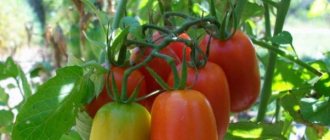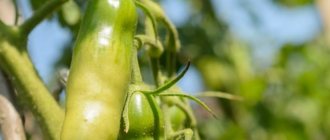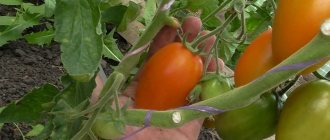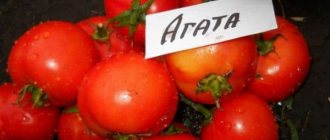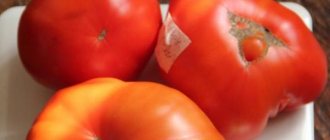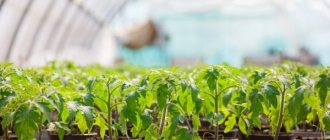| Ripening period: | mid-early |
| Shape, weight of fruits: | round, weight 50-80 grams |
| Bush type: | indeterminate |
| Growing regions: | Southern, Central, Northern |
| Productivity: | 10 kg per sq.m. |
Tomato Tiger Cub is an original variety of Russian origin. Produced by the agricultural company Aelita. The tomatoes got their interesting name due to their unusual striped color. Despite the fact that the tomato is a new product, it quickly gained popularity among farmers. Tiger cub is popular not only because of the attractive appearance of the fruit, the variety gives good yield and is famous for its high taste properties. It is allowed to plant in protected structures and in open beds in all regions of Russia.
Characteristics of the variety and description of the fruits
The Tiger Cub tomato belongs to indeterminate crops; in closed greenhouses it grows up to 2 meters; in the open air the bush reaches one and a half meters. Vegetables are formed on brushes, 10 pieces on each. One plant includes 7 brushes.
The first ripe fruits are harvested 110 days after the seedlings appear. Productivity is average, 10-12 kg of tomatoes are harvested per square meter.
According to the characteristics and description of the manufacturer, the tomatoes are round, ripe vegetables have a rich red color, with yellow-orange longitudinal stripes (see photo). Average weight 50-80 grams, the flesh is dense and meaty. The taste is typical tomato, with a slight sourness.
The conditions for growing a variety in open ground affect the quality of the fruit. Long rains and cold weather make tomatoes taste more sour.
The tomato is covered with a thick skin that protects the vegetable from external damage. Thanks to this feature, tomatoes have good shelf life, while the quality characteristics of the fruit are preserved. Tomatoes are not deformed during transportation.
Strong, fleshy tomatoes are ideal for pickling, can be heat-treated for preparing first and second courses, sauces, pastes, and are widely used fresh in slices or in vegetable salads.
Description of the variety “Siberian Tiger”
Description of the Siberian Tiger tomato:
- the plant is tall and when grown indoors its height can reach 1.5-2 m;
- the leaves are long, thick, bright green;
- foliage is average;
- inflorescences of the intermediate type are quite powerful, with a large number of ovaries - 3-7 pieces on one stem;
- Up to 6-8 tomato tassels are formed on one shoot.
Description of fruits
The fruits of the Siberian Tiger tomato, found in our country, have a round shape, resembling a ball or semicircular. The skin of tomatoes is smooth. But American-bred vegetables have a peculiar ribbing. The structure of the fruit is dense, the pulp is tender and fleshy, the skin is thin.
Important! The shape of the fruits of the Siberian Tiger variety may differ among different companies that produce one or another batch of seeds. The color of unripe tomatoes is light green, with characteristic stripes emerging.
It was thanks to them that the variety got its name - “Siberian Tiger”. These stripes make the color of the tomato similar to the color of the animal's skin. Fully ripe tomatoes are purple-pink in color with prominent black lines. Tomato shoulders near the stalk with a blue-violet tint
The color of unripe tomatoes is light green, with characteristic stripes emerging. It was thanks to them that the variety got its name - “Siberian Tiger”. These stripes make the color of the tomato similar to the color of the animal's skin. Fully ripe tomatoes are purple-pink in color with prominent black lines. The tomato's shoulders near the stalk have a blue-violet tint.
The average weight of a ripe tomato is about 150-200 g, on the first cluster up to 300-400 g. The fruits of the Siberian Tiger are multi-chambered, with a large number of medium-sized seeds. The tomato pulp is red, with a sugary structure at the fracture. The taste of tomatoes is sweetish, with a pronounced fruity aroma.
The leaves are emerald in color and medium in size. When growing, bushes must be shaped. Gardeners pinch the top of the plant to prevent the vegetative part from growing.
From the moment the seedlings develop until the harvest ripens, it takes about 3.5 months. After the formation of 4-5 leaves, the first inflorescences are formed. The remaining ovaries are formed after 2-3 leaves. The ovaries are brush-shaped, each of them ripens about 8-12 tomatoes.
The fruits are round in shape and resemble apples in color and appearance. The weight of one fruit is 40-80 g. Tomatoes have juicy, dense pulp. The skin of tomatoes is dense and does not crack. The color of ripe specimens is red with orange stripes, they are similar to the color of the skin of a tiger cub.
The Siberian Tiger tomato was created by US scientist breeders under the leadership of Mark McCaslin by crossing two other types of tomatoes - the King of Beauty and the Blue. This vegetable belongs to the indeterminate species and is rightfully considered an exotic variety. This tomato is included in the State Register in 2021.
We invite you to familiarize yourself with Motherwort for nursing mothers
Description of fruits
And it was not created in Siberia, as it turned out, but in one of the warmest countries in the world - the USA. This is an outright hybrid and they treat it differently, not everyone approves. But it’s too beautiful! American breeder Mark McCaslin obtained this species by crossing the King of Beauty and Blue varieties.
This variety is indeterminate - that is, it will grow indefinitely unless the top is removed. And you will have to fight your way through your own greenhouse with a machete in your hands. I removed the tops and limited the growth of the bush. The variety is mid-season, that is, the fruits ripen three to four months after germination.
Tiger striped tomatoes are round, medium-sized, red with yellow stripes, thick skin, good for canning and freezing. Fruit weight is 30-50 grams.
The variety is mid-season, productive, recommended for cultivation in open ground and greenhouses. Bush up to 1.5 meters high. Requires tying to the support and pinning. Good results are obtained by forming a plant with 2 stems.
If you grew Tiger tomatoes, please write whether you liked them or not. What was the yield and taste of the fruits like under your climatic conditions? Briefly describe the advantages and disadvantages of this tomato in your opinion. If possible, attach a photo of these tomatoes to your comment. Thank you!
Your feedback and additions to the description will help many gardeners evaluate the variety objectively and decide whether to plant it or not.
This is a natural variety of tomato. Therefore, we recommend taking seeds from a ripe fruit and growing them again next season!
Planting dates and care features
Tomato seeds for the greenhouse are sown in February, 60 days before the planned transplant. Growing tomatoes in open ground involves planting in March, 65 days before the expected movement of the seedlings. The exact dates are set depending on the climatic characteristics of a particular region.
During the final relocation of the bushes, plants are placed 3-4 pieces per square meter.
Tiger Cub tomatoes are grown in compliance with a number of agrotechnical measures developed for this crop. Tomato care measures:
- Bush formation. A productive and high-quality harvest is observed when the plant is grown in 2 or 3 trunks. You cannot leave more stems, otherwise the vegetables will not have time to ripen.
- Garter . Since the Tiger Cub is of the indeterminate type, fixation to a support is mandatory. The stem is attached as it grows; the brushes do not require garter.
- Stepsonning. Removing side branches is necessary, since excess greenery absorbs nutrients and, as a result, the quality of the fruit suffers. Tomato planting is carried out once a week.
- Watering. In open ground, watering is practiced at the root. Frequency depends on weather conditions. Moisturize as needed, approximately once every 5-7 days. It is important to monitor the condition of the soil and not allow it to dry out. During the fruiting period, water more often. Drip irrigation is recommended in the greenhouse. Immediately after the procedure, the ground is loosened.
- Feeding. Seedlings are fed with organic matter and nitrogen fertilizers. When pouring fruit, the plant needs mineral nutrition. Complex fertilizers containing potassium, calcium and phosphorus are suitable.
To stop the growth of the vegetative part of the bush, pinch the top.
Low-growing varieties of tomatoes for greenhouses and open ground
Subscribe
Tomatoes of low-growing varieties are gaining great popularity among gardeners due to their early ripening and ease of care. To get the desired tomato harvest in your region and different growing methods, you need to choose the right variety. The article describes the main types of raceme and low-growing tomatoes.
Features of low-growing varieties
There are three groups of this type of tomato:
| Group | Characteristic |
| Determinant | They are used for growing in open ground, unheated greenhouses and greenhouses. They are not tall (maximum one meter), the stem is low, the inflorescences and leaves are quite densely arranged. The stepsons of these plants do not need to be removed. |
| Semi-determinate | They reach a height of 1.2 m and after the formation of 10-12 inflorescences, their growth stops. Pruning is carried out only if it is necessary to increase early ripening. |
| Superdeterminate | They grow up to a meter in height and are distinguished by their early maturity. This quality is their main advantage and is planted to get an early harvest. The fruits ripen almost simultaneously and then new ones are no longer formed. |
Schematic difference between determinate and indeterminate varieties of tomatoes
The advantage of low-growing tomato varieties is their compactness, which makes it possible to grow them in any way, including on a windowsill. They require a minimum of care, but are characterized by good productivity. And rapid fruit ripening increases resistance to late blight.
A disadvantage of some tomato varieties may be the formation of a stepchild, which affects the size and number of fruits. The person himself will have to decide whether to leave them or delete them, depending on what he wants to get as a result.
The best varieties of low-growing tomatoes of each type
- The most productive low-growing varieties : Snowdrop, Winter Cherry, Polar, Taimyr, Bullfinch.
- Early (early ripening) varieties : Aurora F1, Arctic, Gavrosh, Linda, Lyana.
- For the middle zone : White filling, Marusya, Tsar Bell, Salting miracle, Countryman, Irina, Portland.
- For Siberia (Ural) : Velmozha, Varvara, Glossy, Gina, Biysk Rozan, Ural F1, Bull's Heart.
- Those who do not suffer from late blight : Dubok, Gnome, Metelitsa, Academician Sakharov, Tsar Peter.
- For the window sill (balcony) : Minibell, Tiny Tim, Florida Petite, Angelica, Pearl.
Fruit color palette
- Pink : Pink Honey, Pink Flamingo, Supermodel, Barmaley, Wonder of the Earth, Arctic.
- Yellow : Pear yellow, Date yellow, Heart of the Dragon, Altai strongman, Chukhloma, Pepper yellow.
- Black : Black bunch, Ashkelon, Ashdod, Black prince, Black pear, Monisto chocolate, Gypsy.
- Orange : Orange Princess, Orange, Bull's Heart Orange, Firebird F1, Orange Jubilee, Zero, Koenigsberg Gold.
Description of varieties
To get the desired result, you need to know exactly which variety of tomato is suitable for a certain growing method and climate of the region. The information below will help answer these questions.
Low-growing varieties of tomatoes for greenhouses
When choosing tomato varieties for a polycarbonate greenhouse, they usually choose tall bushes that need to be tied up and pinched. But there are times when there is not so much time for care, and then self-pollinating low-growing varieties are best suited.
| Name of variety (hybrid) | Characteristic | Photo |
| Magnus F1 | The growing season is about two months, therefore it is an ultra-early ripening variety. It is characterized by high resistance to diseases and good yield. The fruits are red, round in shape and weighing 150-180 g. The bushes are compact, you can plant 4 plants per meter, which makes it possible to increase the yield several times. The only requirement for cultivation is to avoid condensation in the greenhouse and its regular ventilation. | |
| The Velvet season | The shortest variety of tomatoes, about 50 cm in height. Belongs to Siberian selection, high resistance to disease, fleshy red fruits weighing up to 300 g. | |
| Alaska | Bushes up to 0.6 m in height, red fruits up to 15 cm long and weighing 90 g with a sweet taste. You can harvest about 5 kg of harvest from one bush. It belongs to the salad species and is not very suitable for preservation, so it is recommended to plant it together with other varieties of tomatoes. |
Low-growing varieties of tomatoes for open ground
The modern choice of tomatoes is very wide, but choosing the right variety with the necessary qualities is not so easy. Let's look at the most popular tomato varieties:
| Name of variety (hybrid) | Characteristic | Photo |
| Supermodel | A low bush up to 0.75 m, it is a mid-early variety. The fruits are crimson in color, up to 12 cm long and weighing 100-120 g. It is used for canning and pickling. | |
| Skorospelka | From the name it is already clear about its early ripeness. The main advantage of the variety is its unpretentiousness in cultivation and easily tolerates low temperatures. The fruits are red in color, weighing up to 180 g and round in shape. Bush up to 0.6 m in height. | |
| Mystery | It tolerates shaded areas well and is perfect for pickling, since the fruits have high taste. The weight of tomatoes ranges from 80 g to 100 g. About 5 pieces are formed on the brush. | |
| Siberian | This is a late variety that tolerates fairly low temperatures well, which is why it got this name. The tomatoes are red in color, weighing about 100 g and medium-sized. Productivity is about 3 kg per bush. | |
| Altaechka | Standard variety of tomato. It is characterized by high yield and high resistance to late blight. The fruits are heart-shaped, beautifully colored and weighing up to 300 g. |
The sweetest low-growing varieties
For many people, the most important quality when choosing tomato seedlings is their sweetness and fleshiness, usually these are hybrid varieties. Therefore, we will separately consider several representatives of this species:
| Name of variety (hybrid) | Characteristic | Photo |
| Haiduk F1 | Refers to ultra-early ripening varieties with high yields. The fruits ripen in a maximum of 3 months, are red in color and weigh about 150 g. They are highly resistant to weather conditions, diseases and yield a good harvest. | |
| Big Mama | It is also an early variety, characterized by high yield and resistance to diseases. The tomatoes are heart-shaped, red in color and weighing 350 g. | |
| Quiz | The ripening time reaches 3.5 months. Red fruits with fleshy pulp up to 200 g, more suitable for salads. | |
| Pink flamingo | Belongs to mid-early varieties. Tomatoes are cream-shaped, red in color and weigh about 170 g. They are high-yielding and resistant to pathogens. | |
| Siberian Troika | A standard mid-early variety with a yield of up to 5 kg per bush. The tomatoes have a pepper-shaped shape weighing up to 350 g. |
Low growing cherry tomatoes
Small-fruited cherry tomatoes are very popular. They are widely used to make beautiful dishes, decorations and preserves. Some representatives of this type of tomato:
| Name of variety (hybrid) | Characteristic | Photo |
| Florida Petite | The height of the bushes is about 30 cm. These are ground tomatoes that are not hybrids. The harvest is produced under any climatic conditions. Ripening begins after three months, the weight of the fruit is about 20 g. At the same time, the yield is more than 4 kg per bush. | |
| Ladybug | An ultra variety that is grown in greenhouse conditions. The height of the bushes is about 40 cm. The fruits weigh up to 20 g with a bright red color. | |
| Vershok | Used only for growing indoors. Up to 60 cm high, red tomatoes weighing about 20 g. | |
| Minibel | Suitable for growing on the balcony. Productivity reaches 1 kg per bush, which is up to 50 cm in height. Fruiting begins after three months, fruits weighing 25 g. |
Without stepsoning
The removal of tomato shoots is carried out in order to increase the yield and ripening time. But, when you don’t have time to do this, you can choose varieties that do not require this procedure.
| Name of variety (hybrid) | Characteristic | Photo |
| Fighter | The start time of ripening is just over three months. The fruits are red in color, weighing about 85 g. Up to 3 kg of harvest can be harvested from one bush. | |
| Dwarf | The bushes grow no more than 0.6 m in height. The fruits ripen in 3 to 4 months and weigh about 60 g. They have a good taste. | |
| Moskvich | The tomatoes are red in color, weigh 80-90 g and ripening begins in the middle of the fourth month. They are well suited for canning. | |
| Snowdrop | Fruits weighing 100-150 g with a smooth surface and red color. It is a cold-resistant variety, hence the name. | |
| Watercolor | Suitable for growing in a greenhouse. Tomatoes weighing up to 50-60 g are red in color. Ripening is from 3 to 4 months. |
Reviews
Most gardeners advise planting low-growing tomato bushes as close as possible in order to get a much larger harvest. Another advantage is the ability to grow low-growing varieties in a greenhouse using hydroponics, while the room itself can be made much smaller, which allows you to save on construction costs.
An important advantage is that some varieties can be sown and grown all year round, due to their small size.
The compactness of these types of tomatoes becomes a disadvantage for many people. Some varieties, forming stepchildren, take root and new bushes are obtained. This reduces the size of the fruits and increases their ripening time.
For those who want to grow seedlings of low-growing tomatoes on their own, most people advise digging seeds from Sedek.
Source: https://mr-ogorodnik.ru/sorta/tomaty/nizkoroslye/
Resistance to diseases and pests
Breeders have endowed the Tiger Cub tomato with natural resistance to typical nightshade pathologies. In particular, the variety rarely suffers from late blight and gray rot. However, when growing in greenhouses, it is worth adhering to preventive measures against fungal diseases: regularly ventilate the room, observe the frequency of watering.
Regular removal of weeds is necessary, as they create a favorable environment for the development of fungal and bacterial infections.
Among the pests, the Tiger Cub is attacked by whiteflies, aphids, cutworms, and spider mites. Insecticides or spraying with folk remedies will help you cope with parasites. Fufanon is considered an effective drug. It is characterized by a wide spectrum of action, safety, and is allowed for spraying in open areas and in protected structures.
As a natural remedy, an infusion of garlic is used, which is used to treat the affected parts of plants.
Early low-growing tomatoes: growing features
Tomato is one of the most popular vegetables on our table. There is hardly a gardener who does not grow tomatoes, because they are one of the main ingredients for many dishes. Modern gardeners have access to dozens of different varieties of this crop, each of which has its own unique properties.
Characteristics of culture
All varieties of tomatoes can be divided into 2 main groups:
- Tall (indeterminate).
- Low-growing (determinant).
The latter are most often grown in open ground, where there are no problems with sown area, and, accordingly, there is no point in sending shoots up. Tall varieties, on the contrary, are used when grown in greenhouses, where it is necessary to achieve maximum yield per 1 square meter. m. area.
It is about low-growing varieties of tomatoes that will be discussed further.
All varieties of this group are divided into three subgroups:
- Determinant.
- Semi-determinant.
- Superdeterminant.
In simple words, the first subgroup represents the highest varieties of the crop. The height of plants in this subgroup does not exceed 1.2 m. They are ideal for growing in open ground. Semi-determinate varieties reach a height of up to 1.3 m. Super-determinate varieties of tomatoes are the shortest.
The bush of the plant does not exceed 1 meter. The main advantage of such varieties is their early ripening. In most cases, only a few bushes are planted to get early fruits. Their peculiarity is that the fruits on all plants ripen almost simultaneously.
However, after this, useful ovaries do not form on the plants.
Varieties of early low-growing tomatoes
Low-growing types of tomatoes are represented by a large number of varieties that differ from each other in the size of the fruits, their color, and the size of the bush.
The most popular varieties among large-fruited tomatoes of the low-growing group are:
- "The Chosen One"
- "Winnie the Pooh".
- "Hermitage Museum".
- "Rajah".
The most common hybrid varieties are:
- "Simone".
- "Torbay".
- "Darling."
Small-fruited varieties of tomatoes have become very popular recently. They are mainly used for canning or for decorating various dishes. Varieties such as “Boni-M”, whose fruits are bright red in color, “Izyum” or “Salut” with yellow fruits, have proven themselves well as a garden crop.
How to grow early tomatoes. Preparing the seedlings
To achieve good results from low-growing tomatoes, you must strictly follow the recommendations for growing them. In our climatic conditions, the most preferable method of growing plants from seedlings. At the same time, by the onset of warm, stable weather, you will already have planting material, which will allow you to get early fruits.
The most important points in growing seedlings are the correct selection of soil and seeds. The following recommendations are guaranteed to help avoid problems and prepare high-quality planting material.
It is better to buy seeds in trusted and specialized stores; this will guarantee that you will not purchase a fake.
No, this does not mean that a plant will not grow from fake seeds, however, no one can guarantee what quality the fruits will be. Pay attention to the packaging.
It must indicate the variety, manufacturer, number of seeds, and date of manufacture. You should not buy seeding material whose expiration date has expired.
Typically, seeds do not need special preparation before sowing, but to protect them from diseases they can be soaked in a solution of potassium permanganate or hydrogen peroxide. For this, the solution must be warm (25-30⁰С). The procedure is carried out right before sowing for half an hour.
Recently, the bubbling procedure has become popular. It consists of saturating the seeds with oxygen before sowing. It won't be difficult to do it at home.
Place the seeds in a small container of water, and lower the tube of an air compressor, such as is used in aquariums, into it. After a 20-30 minute procedure, the seeds are dried and sown. Growth stimulants can be used.
To do this, planting material is soaked in a stimulant solution.
The soil for growing seedlings must be special. It must have enough organic matter to ensure normal growth. Organic compounds can be used as fertilizer. Moisten the soil as needed. If possible, it is better to purchase prepared soil. In this case, a large number of problems will be avoided.
In mid-latitudes, seeds are usually sown in late March - early April. Then, by the time the planting period begins, the seedlings will be able to become sufficiently strong.
Growing order:
- You can plant seeds either in separate containers (a 0.5 liter plastic glass is quite suitable for this) with 1-2 seeds each, or in large seedling boxes at a distance of at least 1 cm from each other. Since tomato seeds are quite large, they can be planted one at a time without any problems. For convenience, you can use tweezers.
- After sowing, the seeds are “covered” with a layer of soil approximately 1 cm thick and slightly moistened. It is better to do this with a spray bottle.
- Next, the seedlings are placed in a small greenhouse. It can be an old box that is covered with film. It is removed as soon as the first shoots appear. After this, the container with the seedlings is placed in a bright place and watered as needed.
- It is advisable to provide additional lighting for the tomatoes; if this is not possible, then it is worth reducing watering and fertilizing the seedlings during rainy days.
Picking seedlings
One of the main conditions for normal growth and future productivity of tomatoes is the picking of seedlings. This procedure is carried out after the second true leaf appears on the seedlings. This procedure involves transplanting tomatoes into a large container. After this operation, the tomato root system becomes more powerful, which is very important for low-growing tomatoes.
Picking is mandatory if the seeds were initially planted not in individual pots, but in a common box. In this case, this operation will help avoid root entanglement and make it easier to transplant plants into open ground. Also, picking can be useful when seedlings are infected with various diseases; this will help save still healthy plants.
In the case of seedlings overgrowing, when there are no suitable conditions for planting in the open ground, picking is carried out to slow down its growth.
Picking low-growing tomatoes is carried out in two ways:
- Transfer. This method consists of moving only the plant to another soil.
- Transshipment. In this case, the plant moves along with the original soil.
Growing early tomatoes
Before planting, you must select the most suitable site. In this case, you should pay attention to crop rotation. Tomatoes grow well after cucumbers, cabbage, carrots, and herbs. It is not advisable to plant tomatoes in the same place for the second year in a row, or after early potatoes, peppers and eggplants.
If necessary, the soil is mulched and fertilized. Tomatoes respond very well to organic fertilizers. The selected area is fertilized with potassium and nitrogen fertilizers, as well as organic mixtures. It is better to do this in autumn or early spring. Wood ash will also not be superfluous. It will be able to normalize the acid-base balance of the soil and add potassium to it.
Many people are interested in when to plant early tomatoes. Planting seedlings in open ground is carried out only when the average daily temperature exceeds +12⁰С. Tomatoes do not tolerate low temperatures very well and may simply die.
Planting is carried out either in the early morning or in the evening, when the sun's activity subsides. Seedlings are planted in holes no more than 10 cm deep at a distance of at least 30 cm.
Approximately 0.5 liters of water are poured into the dug hole, they wait until it “goes away”, a seedling is carefully stuck into the softened soil and sprinkled with soil. Then add a little water.
Water the seedlings as needed within reasonable limits. When watering, be sure to remember that this plant cannot be watered from above. If moisture gets on the surface of the leaf, it can cause disease in the seedlings. After 2-3 weeks of growth, low-growing tomatoes are hilled up, leaving a trench between the rows into which water is poured.
Garter of tomatoes
Some gardeners claim that low-growing tomatoes do not need support. However, most experts agree that this operation is still necessary. The fact is that tomato fruits can create a lot of pressure on its shoots, which in strong winds can cause the stem to break.
The garter can be done in two ways:
- Individual pillar. At a short distance from the root, a wooden or metal rod is inserted into the soil, to which the plant stem is attached with 1-2 pieces of material.
- Trellis. At the end of each row, two supports are installed, between which a wire is stretched. Plants are tied to it.
Diseases and pests of low-growing tomatoes
The most common diseases of tomatoes, including low-growing ones, are:
- Late blight.
- Tobacco mosaic.
- Brown spot.
- Apex rot.
- Fungal infections.
The most common cause of tomato disease is lack of heat and sunlight. This problem is especially acute in northern latitudes, since tomato is a southern vegetable, and its cultivation in open ground leads to similar diseases. Diseases can be prevented by following all the recommendations for growing, timely weeding and watering.
Of the pests that bother tomatoes the most are snails and caterpillars.
Low-growing early varieties of tomatoes: video
Source: https://6cotok.org/800544849073277205/rannie-nizkoroslye-pomidory-osobennosti-vyraschivaniya/
Advantages and disadvantages
It is no coincidence that the Tiger Cub tomato has become popular among farms. Gardeners love the described variety for a number of positive qualities:
- acceptable yield;
- unusual external data;
- high taste properties;
- good keeping quality;
- safety during transportation;
- resists fungal pathologies;
- simple agricultural technology;
- it is permissible to grow both in closed structures and in the open air;
- different ways to use tomatoes in cooking.
Among the disadvantages of the Tiger Cub tomato in reviews, gardeners highlight the need for regular pinching and tying up bushes.
Tiger tomato: variety description, characteristics, yield reviews, photos
Gardeners are trying to choose the best crops for the plot. Each variety must meet their requirements and desires. Many people want to find something universal, reliable, proven. This can be called the Tiger tomato. Farmers claim that such tomato plants can develop well in different conditions, be it open or closed ground.
The attention of many is drawn to this variety because of its interesting coloring. Looking at the external characteristics of tomatoes, you can guess why they were called Tiger. But the unique “appearance” of vegetables is not the only thing that makes this type of crop so popular.
Advantages and disadvantages
Many people choose the Tiger variety because of the opportunity to achieve good yields by growing the crop in open and protected ground. During the growing season, the tomato is not at risk of gray rot and late blight, to which the plant has good immunity.
The advantages include the stability of Tiger. Tomato plants produce tasty, high quality fruits with plenty of dry matter. Sugary and aromatic, subject to long-term storage and transportation. Versatility played an important role in the popularity of the variety.
The disadvantages include the need to create support for plants and carry out pinching.
You may be interested in:
Care
Thorough irrigation is carried out only after transplantation, then you should adhere to the drip irrigation method, uniform. Water is directed under low pressure under the stem so that it reaches the root system. Watering is preferably done in the morning, which allows moisture to be absorbed until night. This prevents the tomato bushes from experiencing a stress response to possible freezing in moist, cool soil.
In terms of fertilizing, it is enough to alternate minerals and organic matter. But you should not ignore symptoms indicating a deficiency of certain compounds.
Sometimes it is necessary to focus on magnesium and calcium in order to achieve balanced development of the plant and avoid diseases and reduced ovary production.
Gardeners should not forget about mulch, which may be needed in cold or hot weather.
Similar varieties and hybrids
Tomato Tiger Cub is sold in gardening stores and online sites. A package of seeds costs 15-19 rubles. This is not the only exotic variety whose skin is tiger-colored. There are other similar tomatoes with similar characteristics:
- De Barao brindle.
It belongs to the indeterminate species, the stem is capable of stretching more than 2 meters. Allowed to be planted in greenhouses and open areas. Since ripe vegetables are harvested 120 days after the seeds germinate, the variety is considered mid-early. Productivity 9-10 kg of vegetables per sq. m.
The tomatoes are round, medium in size, weighing 50-70 grams. The color is patterned, with longitudinal orange stripes clearly visible on a red background. The pulp is tender, sweet in taste, and has a fruity aroma. This tomato variety is resistant to late blight. Price per bag of seeds is 30 rubles.
- Baby Tiger F1.
It is a tall hybrid, suitable for cultivation in open and closed ground. The tomato is ultra-early; no more than 85 days pass from the formation of seedlings to full ripeness of the fruit. The yield is good; if agricultural practices are followed, 13-15 kg of vegetables per square meter are harvested.
The tomatoes are round, slightly elongated, red in color with longitudinal green streaks. Fruit weight 40 grams. The variety is sugary, tastes sweet and juicy. Not susceptible to diseases characteristic of nightshade crops. The price for a pack of seeds is 90 rubles.
- Tigrella.
A medium-sized determinate plant, the stem height reaches 1.4 meters. Can be grown outdoors and in protected structures. The harvest will mature 110-120 days after the appearance of the first sprouts. Productivity is 8-10 kg per sq. m.
Medium-sized tomatoes weigh 60-80 grams. Bright red with orange streaks, slightly flattened in shape. Inside, the fruit is dense, fleshy, and sweet in taste. It resists well the phytopathologies of nightshades. The price for a package of seeds is 40 rubles.
Tomato Tiger: consider thoroughly
The Tiger tomato, or Tiger Cub, is a bright representative of the group of varieties called bicolor. These are tomatoes with variegated, striped or spotted fruits.
Description and characteristics
The first thing to highlight is:
- high productivity;
- pleasant sweet taste;
- interesting fruit color.
Bushes can grow up to one and a half meters. They produce dense, medium-sized foliage. The leaves have a typical tomato shape and color that can vary from light green to dark shades.
The stems are erect, stable and strong. Gardeners who decide to grow the Tiger variety will have to carry out a pinching procedure to slow down the development of green mass.
Without it, caring for the bushes will be difficult, especially in a greenhouse shelter.
The procedure will increase the volume of the harvest, because the nutrients will be directed to the formation of fruits. To secure a tall bush, trellises or other supports are used, to which a garter can be attached.
Advice! The best yield level is observed after the formation of several stems (maximum three) and removal of stepsons.
A detailed description of the fruits of the Tiger variety tomato plant includes features:
- medium size tomatoes;
- round shape;
- red color, complemented by yellowish stripes;
- the skin is dense;
- weight from 30 to 50 grams on average;
- Fleshy fruits are easily held on a strong fibrous stalk.
In many seed catalogs and on various websites, the fruits of this variety are characterized as sweet. But sometimes sourness may appear in the taste. This happens when a gardener waters the crop bushes incorrectly.
The variety is classified as mid-season. From the moment of sowing to the production of ripe fruits, an average of 110 to 120 days pass. Inflorescences of a simple type are formed after the full development of 6 permanent leaves. The next ones can be seen through two or three sheets.
Fact. The plant quickly forms brushes on which 4 to 6 ovaries develop.
By growing the Tiger tomato variety, taking into account the reviews, you can achieve good yields. A square meter occupied by plants will produce up to 5 kg of tomatoes. Due to the characteristics of the culture, the fruiting period is long.
Harvested tomatoes can be transported over long distances. Mechanical damage and loss of taste do not threaten the fruits.
Farmers who choose interesting exotic varieties of tomatoes for sale note the good marketability of the Tiger variety.
In terms of further use, tomatoes are universal. When fresh, they delight with a pleasant sweetish taste, are suitable for canning and are used for processing into tomato juice.
: Tomato Northern blush: we explain in detail
General characteristics of the Tiger variety
The bushes are powerful, up to 100-150 cm in a greenhouse and 80-90 cm in open ground. The plant is of the indeterminate type and continues to grow and set fruit until frost. When cultivating in open ground, it is recommended to artificially stop the growth of stems so that the tomatoes formed at the end of summer have time to grow and ripen.
The formation of a bush is carried out in 2-3 trunks. Plants need pinching. In order for the crop to ripen evenly and be less susceptible to fungal diseases, the tomatoes are tied to a support and the leaves are removed up to 2/3 of the height of the bush, starting from the bottom. In this case, you can only remove those leaves that grow below the forming tassel with flowers.
From 1 bush you can collect 3-5 kg of marketable products. The fruits are small (the weight of 1 tomato is 60-80 g), collected in beautiful clusters consisting of 7-12 approximately identical ovaries. Fruit yield depends on cultivation conditions: the variety bears fruit well on light and loose fertile soils with low acidity.
In the conditions of the Moscow region and regions with heavy and excessively moist soils, it can reduce yields or be susceptible to late blight, alternaria and other fungal infections.
Advantages of striped fruits
The main advantage of Tiger tomatoes is their high decorative properties. Tomatoes at the stage of biological ripeness have an orange-yellow color with blurred red stripes, reminiscent of the coloring of a tiger skin. When unripe, tomatoes are yellowish-green in color with dark green stripes.
The shape of the fruit is perfectly spherical. The surface is smooth and shiny. Planting such tomatoes looks very decorative throughout the season.
The characteristics and description of the variety in seed catalogs classify the plant as a mid-season tomato. The first vegetables can be harvested approximately 110 days after sowing.
In the conditions of central Russia, the Urals and Siberia, this period of the beginning of fruiting forces gardeners to give preference to growing tomatoes in a greenhouse.
But even in the open ground you can get a good harvest by removing some of the fruits at blanche and milky ripeness. Tomatoes store well and ripen in room conditions.
The skin of striped tomatoes is quite durable. They are not prone to cracking during ripening. Thanks to this advantage, Tiger tomatoes can stay on the branches for a long time even in difficult weather conditions.
The flesh of striped tomatoes is pink, dense, and coarse when broken. The sugar content of the fruit reaches 5%, and reviews from gardeners characterize the taste of the tomato as sweet, with a slight sourness. The seed chambers are well developed, the fruit is juicy and aromatic.
The purpose of Tiger tomatoes is considered universal. Tomatoes look good in slices or salads and can decorate vegetable snacks and sandwiches.
Small and dense, neat fruits are convenient to use for whole-fruit canning.
The highly decorative coloring of the tomatoes makes these preparations look elegant, and the elastic skin of the fruit keeps them intact even during heat treatment.
It is not advisable to process beautiful tomatoes into juice or sauce. The dull color of the pulp does not provide these varieties of home canned food with a pleasant color. But for the sake of better taste of lecho or ketchup, tomatoes can be mixed with red varieties. Sweet and fragrant striped tomatoes are well suited for drying.
Cultivation
Tomatoes should be grown in prepared soil in a well-lit area. Planting seeds should be carried out according to generally accepted rules. The seeds must be kept in a manganese solution, and the soil must be mixed with sand and peat. It is recommended to heat the soil in the oven or microwave; this will help destroy fungi and larvae of harmful insects.
The container with the crops is covered with film until the sprouts hatch. Watering and fertilizing are carried out as needed. When 2-3 leaves appear on the shoots, they are dumped into a separate container. Before planting in a greenhouse or garden bed, plants must be hardened off. The mid-season variety tolerates lack of moisture well.
However, to obtain a rich harvest, regular watering is necessary.
Advantages and disadvantages of tomato
Many reviews about the taste and cultivation characteristics characterize the variety well both in closed and open ground conditions.
Advantages attractive when growing:
- original appearance of tomatoes;
- good yield;
- sweetish, juicy taste;
- preservation of presentation during ripening, storage, transportation;
- different ways to eat fresh and canned.
Among the disadvantages is the high growth of shoots that need to be pinched and tied up. But in general, the characteristics of the variety allow you to get a generous harvest in the greenhouse and outdoors.
Irina Sergeevna
I have been planting Tiger tomato for many years. My children like small striped tomatoes. I grow it from my own seeds, sometimes I renew it and buy it in the store. I sow and grow the seeds on the windowsill, and then transplant them into open ground. The variety ripens on site, although some large varieties do not always ripen. Resistant to late blight.
Victoria
I studied the description of the Tiger variety, became interested in the multi-colored color of the fruit, and decided to try to grow it. Tomato bushes are tall. Tomatoes with a sweetish taste. The yield is excellent, almost a bucket per bush. When pickled, ripe fruits crack, but the green-brown ones look beautiful. Keeping quality is average.
: Tomato Velikosvetsky: revealing all the nuances
Landing rules
The basic rules for landing are as follows:
- Sowing work is carried out after treating the seeds with saline solution. You can also use a weak solution of potassium permanganate.
- This is followed by a growth stimulator treatment procedure, which takes no more than 20 minutes.
- The soil should be light and well fertilized. Garden soil is not recommended for use. But, if the farmer forgot to purchase universal soil, you can use garden soil, well heated in the microwave or oven.
- Garden soil is mixed with a small amount of compost.
- It is advisable to cover the containers with film to reliably maintain a temperature favorable for germination.
- You should check the seedlings often so as not to miss the moment when you need to move the pots with sprouts to the sun, preferably to a warm southern windowsill. Alternatively, phytolamps are used, which work up to 14 hours a day for better development of seedlings.
- Recommendations for growing Tiger variety tomatoes mention the need for the first fertilizing when a pair of true leaves is formed. At this time, a small amount of liquid fertilizer, complex mineral type, is used.
- For transplantation, farmers need to wait for a period when external conditions are stable. First of all, you need to make sure that the frost has passed and the soil has had time to warm up.
- An important aspect is air temperature. Young plants have a better chance of doing well in warm weather.
- It is important to choose a lighted area for the bushes. On a square meter, dug up and fertilized in advance, up to four bushes are grown.
- Gardeners who do not have time to periodically thin their bushes should settle for three plants in a plot of the same size. This planting principle will allow you to achieve better results.
Features of cultivation and storage
They are grown only by seedlings, sowing the seeds 60 days before planting. They are cultivated in film and glass greenhouses, forming them into one stem and leaving 5-6 clusters on it.
Rules of care
Timely loosening of the soil and weeding will help get rid of pests and fungi. Fertilizing should be done regularly; organic and mineral fertilizers should be used. Tall bushes must be tied to a support, and stepchildren must be torn off.
Watering is recommended to be done using the drip method. Water should only fall on the root system of the bushes.
Gardeners are advised to regularly visually inspect plants for pests or fungal infections.
If unpleasant symptoms appear, you should remove the affected leaves or branches, collect insects, and treat the bushes with a special preparation. Spraying of bushes is also carried out for preventive purposes.
- Semyon Ivanovich, 67 years old:
I saw the Tiger variety on my sister’s plot. I liked the unusual color. Tomatoes are ideal for pickling in their entirety. The preparations turn out elegant, and the fruits themselves are very dense and tasty. Tomatoes have a sweetish taste, the flesh is juicy, and there are few seed chambers. The only drawback is that the bushes require tying and pinching. Plants are not demanding of water. It seemed to me that, on the contrary, due to lack of moisture, the fruits have a more pronounced taste and aroma. - Victoria Pavlovna, 52 years old:
I learned about this amazing variety from my niece. She has been growing striped tomatoes for several years. This year I planted several bushes in the greenhouse. The result was an excellent, rich harvest. All tomatoes are smooth, round, and perfectly stored fresh, thanks to their high density. The taste is sweet, slightly sour. It was a shame to process such beautiful tomatoes into juice and sauce, so I marinated them whole. I recommend this unusual variety to everyone.
Diseases and pests
The variety is not affected by blossom end rot. With thickening and excessive moisture, outbreaks of late blight are possible. Leaves with spots are torn off and destroyed, the plants are sprayed with phytosporin or trichodermin. The harvest is ready for harvest 5 days after treatment.
Expert opinion
Valentina Rareko
Editor-in-Chief of Repka.online. Experienced summer resident and gardener.
Stuffed tiger tomato can be prepared immediately after harvesting or you can put the filling in the fruit and freeze it in this form until winter. For stuffing, fresh and boiled vegetables, cheese, minced meat, and cereals are used.
| Share on social networks: |
Source: https://alt-zem.org/ovoshhi-i-zelen/tomat-tigrovyy.html
